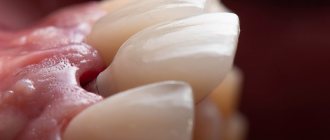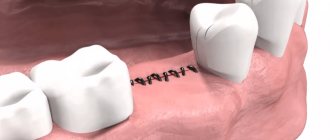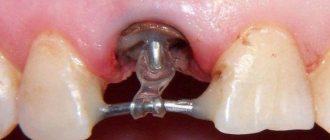- What is a gum former: photo
- What happens after a healing abutment is installed?
- Why does my gum hurt after inserting a gum former?
- The gum former fell out: what to do
- How long to wear
- Gum former: how long does it take to heal?
- How to place a gum former
- Possible complications
- Is it possible to do without a gum former?
- What manufacturers are there?
Dental implantation is one of the most modern and effective methods of orthopedic dentistry. It allows you to restore the integrity of the dentition, correct aesthetic defects and restore the functionality of the dental system. The essence of the procedure is to perform an operation with the installation of an implant, onto which a prosthesis is subsequently attached. Some patients still believe that implantation is an expensive service that is not available to many people. Nowadays it is possible to purchase all consumables at an affordable price; everyone can restore long-missing teeth and restore an attractive appearance to their smile.
Patients have many questions regarding the specifics of implantation, what stages it consists of, etc. An artificial tooth consists of several important elements; in addition to the titanium root, other products are involved in its formation. For example, a gum former device, little is known about it, but without it it is impossible to perform an operation. Today we decided to answer the most common questions about this product, why it is needed at all, what it looks like and what it consists of.
The absence of one or more teeth is a problem that every person can face. The patient almost immediately contacts the dentist for help when a defect occurs on the front part of the dentition, because he is noticeable to others, and he will no longer be able to simply smile. In the event that a molar is lost, which may not be visible, then treatment is postponed until later. Delay is fraught with serious consequences, which makes it difficult to carry out high-quality prosthetics.
The specialists of the A-medic clinic are often asked the following questions regarding the installation and care of the gum former. We answer the most popular and useful of them.
Appearance of the gum former
The gum former looks like a thick screw with a small thread pitch. On its upper part there is a thick head. The diameter and shape of the upper surface of the head exactly corresponds to the base of the future tooth, and the lower part of the head, accordingly, has the shape of the top of an already installed artificial root. It turns out that the gum former exactly repeats the shape of the teeth and roots in their normal state.
The pin of the gum former has a thread that serves to screw it tightly into the artificial tooth root.
Gum formers are made individually and only for one specific tooth. This device is designed to form a hole in the gum where the artificial tooth will be located. The success of the installation of the gum former determines how tightly the artificial tooth will adhere to the gum. This is a very important point. The fact is that if the gum does not fit tightly around the tooth, then food will get into the gap. It is not so easy to remove it from there, and therefore gum inflammation is possible.
Operating principle of the shaper
Structurally and externally, this element screwed into the implant has some similarities with an abutment. But their purpose and tasks differ. The latter serves as a transition link between the implant and the crown and performs an important function of support for the future tooth. Therefore, it must be especially reliable in order to withstand full chewing loads. The first is used only to ensure the aesthetic formation of gums during dental implantation. The period of use is short-term - two to three weeks. For this period:
- soft tissue heals after repeated surgery;
- the gum volume is evenly distributed around the former;
- a so-called pink aesthetic is created, that is, the gingival contour takes on a harmonious appearance.
Since the shaper is used for a short time, the requirements for its strength are low.
What is the gum abutment made of?
The best material for making a gum former is titanium. This metal is very light and extremely durable. In an aggressive environment, and the oral cavity is such for metal, titanium does not oxidize at all. In essence, this would be an ideal option for such a product, if not for one “but”.
The fact is that titanium is visible through the gum. For those people whose gums are visible when they smile, this option is not suitable. They prefer to install a healing abutment made of zirconium. This material does not have this drawback.
Abutment and healing abutment
The technology of implanting artificial teeth along with gum formers allows the use of abutments. This is a completely different device, designed for installation in an artificial root after the gums have formed. It is installed in place of the gum former and serves to fit the tooth more tightly into the root.
The top of the abutment has a completely different shape than the healing abutment. It is made individually for each tooth. There are several types of abutments: temporary, standard, angled, cast and custom. These devices are made of ceramic, titanium, gold, plastic or special alloys.
Classification
In dentistry, it is customary to classify gum formers according to quality of manufacture and cost.
The economy class includes gum formers produced by Adin, Alpha Bio, MIS, Iterum (Israel), Bicon (USA), Implantium (Korea, USA).
Business class products are produced by the only German company in the world, Xive. Manufacturers of premium gum holders are Straumann (Switzerland), Astra tech (Sweden), Nico, Ankylos, Impro, Semandos (Germany), Nobel Biocare (USA).
Even though gum formers from one company are suitable for installing implants from other companies, dentists still recommend using all products from the same manufacturer.
Installation sequence
The length of time required to prepare for the placement of a healing abutment may vary. This depends on the extent of preparatory measures. Sometimes this process lasts for six months, and sometimes only for a few days. The operation itself does not last long. During a standard installation, it is done in the following sequence:
- - local anesthesia is given;
- — an incision is made in soft tissue to gain access to the fastening;
- - excess soft tissue is cut out;
- — the plug is removed from the implant;
- — manually or with a ratchet, screw the former into the root.
- - stitches are placed on the cuts.
Preparation for dental implantation
Preparation is considered one of the most important stages, along with the actual implantation. At this stage, the type of upcoming prosthetics is determined, suitable implants are selected, the patient’s health condition is studied, and potential contraindications to surgery are identified.
Preparation includes several processes:
- examination and consultation with a dentist;
- assessment of the volume and quality of bone tissue;
- tests and examinations - CT scan, x-ray, blood test;
- examination and consultation with specialized specialists (carried out in the presence of chronic diseases);
- choice of implantation technique (single-stage, two-stage), selection of implants and prostheses;
- sanitation of the oral cavity, treatment of all dental diseases so that in the future they do not become a source of infection and cause implant rejection.
The result of the operation and the successful implantation of the implant depend on proper preparation.
How long do you have to wear a gum former?
After installation of the former, the gums usually heal within a week, but this does not happen in all patients. In any case, only the doctor determines the readiness of the oral cavity for surgery.
Separately, it is necessary to say about bleeding from the gums after installing the former. For most patients, this ends on the second or third day. However, for many, the ichor oozes for much longer. You shouldn’t be afraid of this, since these are simply individual characteristics of the body in terms of blood clotting. Statistics show that you have to wear a gum former for no longer than two weeks. After this, the former is unscrewed to take an impression for the prosthesis.
The essence of the formation of the hole is the flow of soft tissues around the gum former. Of course, they cannot adhere to the surface of the former, but they adhere to it very tightly. As a rule, this process occurs evenly along the entire circumference of the former. Only in rare cases does the overgrowth occur unevenly. In this case, surgical intervention is required.
Contraindications
Implantation involves surgical intervention, like any other operation, it has its contraindications. In some cases, this method of dental restoration may not be recommended. Therefore, first the dentist conducts an examination and examination, based on the results of which he determines the presence of diseases and other conditions that may interfere with implantation. Absolute contraindications include:
- Osteoporosis.
- Mental disorders.
- Malignant neoplasms.
- Blood clotting disorders.
- Severe forms of diseases of the cardiovascular or respiratory system.
- Allergy to anesthetic drugs.
- Diseases of the immune system.
Possible complications after the installation of a gum former
Unfortunately, the process of gum formation can be complicated by considerable troubles. Most often they are caused by a doctor’s error, less often by the characteristics of the patient’s body.
The doctor’s mistake is also considered to be the fact that he did not find out whether the patient is susceptible to an allergic reaction to painkillers. If such a reaction exists, then after installing the former in the patient’s oral cavity, an inflammatory process may begin. It should be said that the shaper itself cannot cause an allergic reaction.
Sometimes after installing the shaper, the pain does not disappear, but, on the contrary, intensifies. This is a sign of inflammation of the soft tissues or a violation of the tightness of the sutures. In this case, the patient is prescribed antibiotics and new sutures are placed. Sometimes swelling of the cheek occurs after surgery. This is not an anomaly, and the swelling soon goes away on its own.
It also happens that the former puts too much pressure on the gum, causing it to become inflamed. In this case, all the blame lies with the doctor, because he incorrectly calculated the size of the shaper. Such a former has to be replaced with another. It is very bad if the shaper begins to wobble a few days after installation. This can happen from a loose fit into the root or a loose fit of the artificial root into the bone. A loose root may be due to insufficient bone density. In this case, the doctor prescribes calcium for use. If the density of the bone tissue is high, and the former wobbles along with the root, it means that the body has not accepted the foreign body and rejects it. Soon an inflammatory process will begin under the root. To avoid this, the former is removed along with the root.
Sometimes the gums bleed for a long time under the stitches, although the stitches were applied correctly. There is only one reason for this: the patient’s weak blood clotting ability. In this case, you should definitely consult a doctor.
It is very important to know that if you do not follow all the doctor's recommendations, then in the postoperative period you may experience such unpleasant things as tumors, toothache, neck pain or sore throat and ear.
What can happen if the healing abutment is not installed correctly?
Correct installation of the gum former is a guarantee that the implantation of an artificial tooth will be completed successfully because the socket for the prosthesis will be formed as needed. If the shaper is not installed accurately, then the hole will not be formed as it should be.
If the root is planted too deep into the bone, then the former will not be installed correctly. Soon it will begin to wobble and then fall out. This happens because bone tissue will begin to grow on the root and displace the former. In such a situation, the doctor cuts off the growth of bone tissue, and the structure will soon strengthen itself.
If the former suddenly falls out of the root, you need to immediately screw it into place yourself and see a doctor as quickly as possible. You cannot delay your visit, because the hole begins to overgrow very quickly. A late visit means that you will have to start installing the former again, which means cutting the gum again.
It also happens that the soft gum tissue completely covers the entire former. This is the result of a doctor’s mistake who incorrectly calculated the size of the shaper. In this case, you have to install a new, higher former. An incorrectly installed gum former that is too high causes discomfort when eating. This situation also requires replacing the former with a lower one.
Prosthetics
The final stage of implantation, at which the patient is fitted with the selected prostheses. These can be individual crowns or dentures that replace several teeth at once, removable or fixed, bridges and others.
Impressions are taken from the patient’s jaw and prosthetics of the chosen design are made from them. After fitting and correction, final installation occurs.
After this, the patient can return to normal life, but with adjustments to the dentures - for several months it is necessary to follow the specialist’s recommendations, monitor oral hygiene and not overload the new teeth.
How to care for your mouth after a gum former is installed?
After installing the gum former, you need to take care of your oral cavity in full, but in a gentle manner. The first thing we recommend is to change your hard toothbrush to a soft one. In this case, when brushing your teeth, you will not disturb the gums, and most importantly, the stitches. At this time, you need to brush your teeth without any pressure on the brush. If you want, you don’t need to clean them, but gently iron them. If the former suddenly falls out while brushing your teeth or eating, you should screw it back into place and immediately go to the doctor. Along with brushing your teeth, it is recommended to rinse your mouth with a saturated saline solution several times a day during the postoperative period. It is best to use sea or iodized salt. This procedure successfully prevents the occurrence of inflammatory processes.
A solution of hydrogen peroxide, tincture of calendula flowers, a decoction of echinacea root, a mixture of honey and salt, and some essential oils have similar properties.
Symptoms of implant rejection
The first signs of reimplantitis:
- Pain;
- Swelling;
- Bleeding;
- Feeling of discomfort.
If you don’t see a dentist with these signs, the situation will get worse. The following symptoms will be added:
- Implant mobility;
- Growing pain;
- Bad breath;
- Pus appears in the area of the operation;
- Body temperature rises.
- The gum cuff changes due to the inflammatory process.
Advice for pregnant women
In case of emergency, dental implantation can be done during pregnancy, but there are strict restrictions. So, this is strictly forbidden to do this in the first and third trimester, but in the second trimester it is possible. In this case, it is necessary to take into account the likelihood that after installing the gum former, the patient will have to take medications. This is not at all desirable for the fetus. The second point is that when installing a gum former, local anesthesia is used, and this will certainly affect the condition of the fetus. If it is possible to postpone implantation until the baby is born, then it is better to do just that.
How expensive is implantation?
In conclusion, let’s say a few words about the cost of dental implantation. The cost of this operation largely depends not on the cost of dental labor, but on the cost of the materials from which the implants are made. In addition, real prestige and the manufacturer’s own self-esteem bring their own adjustments to pricing.
Also, the price depends on the class of implants; the higher it is, the higher the price. The cost of implants from European manufacturers is much higher than that of their American and Australian counterparts.
The most inexpensive implants currently are Israeli ones.











